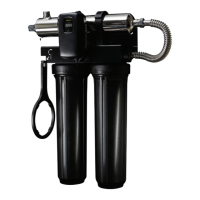13
Step 11: Replace the o-ring and slide the sleeve back into the reactor following steps 7
and 8 from the installation section of the manual.
Cleaning the UV Sensor
Depending on the water quality, the quartz sleeve may require periodic cleaning. At
a minimum, the quartz sleeve should be cleaned on an annual basis. The following
steps outline a basic clean-ing procedure.
Step 1: If a by-pass assembly is installed, shut the inlet valve off to prevent water
owthroughthesystem.Otherwise,turnoffmainwaterinletvalve(and/or
turn off the water pump).
Step 2: Disconnect power cord of UV system from electrical outlet.
Step 3: Release water pressure by opening a downstream faucet and then close
the outlet shut-off valve (if any). If there is no outlet shut-off valve, expect
water to drain from the system as the head pressure in the system will
causethewatertoowbackdown.
Step 4: Place something under the reactor to catch any water that may come out of
the reactor during the removal of the UV sensor.
Step 5: Unscrew (counterclockwise) sensor nut from the reactor and pull the sensor
slowly out of the sensor port.
Step 6: Holdingthesensorinyourhandwipetheatportion(sensorface)ofthe
sensor with isopropyl alcohol using a clean lint-free cloth.
Step 7: Replace sensor following step 9 from the installation section of the manual.
Operation
Microlene systems come with a feature laden controller that incorporates both
the lamp driver (ballast) and control features in one water-tight case. Four main
controllers are available for the Microlene systems (depending on your model). All
four models feature a power factor corrected, constant current lamp driver with a
universal power input.
Please Note: While the LED or display screen is red and the buzzer is sounding the
water from the system should NOT be consumed. If any water does pass through
the system during this period, please follow the disinfection procedure as outlined
in this manual before the water is consumed. For Microlene systems, even though
they have a visual and audible warning built into the controller, a green LED or status
screen does not necessarily indicate that the water coming from this system is in fact
potable(safetodrink).Thesesystemsdonotmeasurethelevelofdis-infection;they
simplymeasurethe“on-off”statusofthelamp.Pleasehaveyourwatercheckedfor
microbiological contaminants on a regular basis.

